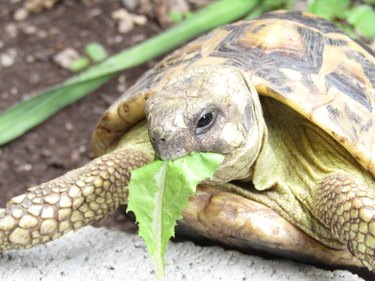Turtles mate in order to reproduce. Though the habitats of land turtles and sea turtles differ, they mate in the same way. Mating is a dangerous activity for both male and female turtles. After a female turtle lays her eggs, she abandons her nest, forcing her offspring to begin fending for themselves immediately after they hatch. Most species of turtles don't spend a lot of time together. Rather, they come together during mating season. There are exceptions, of course.

Video of the Day
Turtles migrate to mate
One type of turtle, the Hawaiian green sea turtles, spend a lot of time with each other throughout the entire year. Mating season usually begins when the days begin to get longer, and the local temperature begins to rise. Temperature actually determines what sex of hatchlings will be born. Warmer temperatures produce female hatchlings, while cooler temperatures produce males. Females must lay their eggs while the temperature is just right in order to produce both male and female hatchlings.
Video of the Day
When it's time to mate, turtles will return to the beach where they hatched. While females only return every two or three years to mate, males return to the mating site annually.
How turtles mate
When a female accepts a male as a mating partner, the male will get on top of the female's back. The male holds onto the lead edge of the female's shell with the long claws he has on his front flippers. These claws often dig into the soft skin around the female's shell, causing her to bleed.
Turtles have cloaca at the base of their tail that contain their reproductive organ. Once a male has mounted a female, he uses his long penis to inseminate the female's cloaca. After he is finished, a male will try to hang onto the female to prevent other males from mating with her. During this time, other males will try to get him off the female by biting his front flippers and tail.
Turtle mating is a dangerous business
Mating is dangerous for female sea turtles. Females must support their weight and their partner's weight when he is on top of her as well as swim and reach the surface of the water often enough for her and her partner to breathe. If a female cannot do this, she may drown.
Mating is also dangerous for males. A male can fall off his mating partner during the mating process and land on his back. If he's not able to flip himself over, he can die.
Turtles lay eggs
A female will mate with as many males as necessary in order to have enough sperm to fertilize her clutches. Turtles must find appropriate conditions on land to nest their eggs. Sea turtles must venture out of the water onto land to find nesting spots. Once a female has found a nesting spot, she digs a chamber for her eggs in which to incubate until they're ready to hatch.
The number of eggs a female lays per clutch depends on her species. Some species only lay one or two eggs per clutch, while others lay over 100 eggs per clutch. While some species of turtles only lay one or two clutches during mating season, several species of sea turtles lay several clutches.
After she lays her clutch, a female will cover her eggs with sand. Incubation time is temperature-dependent. On average, the incubation period lasts for 45 to 75 days. A female turtle leaves her eggs after burying them, forcing her hatchlings to begin fending for themselves immediately after they hatch.